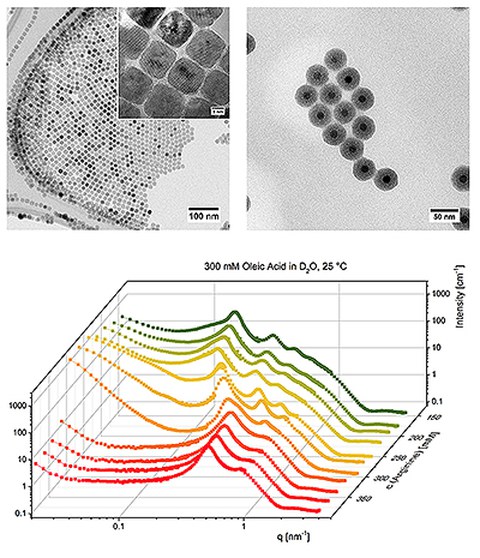M. Gradzielski: Magnetic field and temperature sensitive hybrid materials with rheological control: interaction of magnetic nanoparticles with a gel network in AC, DC and AC+DC fields, investigated by high frequency SANS
Description
Thermoreversible ferrohydrogels, with magnetic nanoparticles (NP) incorporated in the gel matrix, will be studied as archetypal multi-scale responsive hybrid smart materials. The aim is to elucidate the interplay between NP and the crystalline fibril network under AC and/or DC magnetic field to enable the control and modification of their macroscopic rheology.
The main investigative tool will be small angle neutron scattering (SANS), with AC and/or DC magnetic field. SANS is unique for such complex composite materials in that it probes the nanoscale (fibrils, locus of particles), also dynamically (transient structures, Néel and Brownian relaxations, using time-stamped neutrons, with 0.1 µs resolution), extract individual components by selective nuclear contrast matching, and distinguish nuclear and magnetic domains using polarized neutrons.
Physical parameters to be varied are the stiffness of the fibrils, the adhesion strength at NP/fibrils junctions, the mesh size, density of nodes and number of junctions (controlled by concentrations of gelator and particles).
Different results are expected based on the strength and number of junctions relative to the field strength and frequency, with rotation and locomotion of particles being allowed or inhibited. Temperature as a stimulus will provide annealing of any structure, gelation under field to retain structures etc., leading to reversible memory features of shapes and magnetic properties.

Top: TEM images of monodispers cubic Fe3O4 nanoparticles (left), which can be covered with a silica layer (right). Bottom: SANS curves for gels with constant concentration of 300 mM oleate (T =25°C)
Project Manager
Prof. Michael Gradzielski, Technische Universität Berlin
Staff
Sarah Schatte, Technische Universität Berlin
Grant period
2013 -
Publications
[1] Wiedenmann, A.; Keiderling, U.; Meissner, M.; Wallacher, D.; Gahler, R.; May, R. P.; Prevost, S.; Klokkenburg, A.; Erne, B. H. & Kohlbrecher, J. Low-temperature dynamics of magnetic colloids studied by time-resolved small-angle neutron scattering Physical Review B, 2008, 77 DOI:10.1103/PhysRevB.77.184417
[2] Wiedenmann, A.; Gähler, R.; Dewhurst, C. D.; Keiderling, U.; Prévost, S. & Kohlbrecher, J. Relaxation Mechanisms in Magnetic Colloids Studied by Stroboscopic Spin Polarised SANS Physical Review B, 2011, 84 (21), 214303 DOI:10.1103/PhysRevB.84.214303
[3] Wiedenmann, A.; Gähler, R.; May, R. P.; Keiderling, U.; Habicht, K.; Prévost, S.; Klokkenburg, M.; Erné, B. & Kohlbrecher, J. Eckold, G.; Schober, H. & Nagler, S. E. (Eds.) Stroboscopic Small Angle Neutron Scattering Investigations of Microsecond Dynamics in Magnetic Nanomaterials Springer Series in Solid-State Sciences, Springer-Verlag Berlin Heidelberg, 2010, 161, 241-263 DOI:10.1007/978-3-642-03309-4_9
[4] Klee, A.; Prevost, S.; Kunz, W.; Schweins, R.; Kiefer, K. & Gradzielski, M. Magnetic microemulsions based on magnetic ionic liquids Physical Chemistry Chemical Physics, 2012, 14, 15355-15360 DOI:10.1039/c2cp43048g
Contact
Technische Universität Berlin
Fakultät II
Institut für Chemie
Sekretariat TC 7
Straße des 17. Juni 124
10623 Berlin
